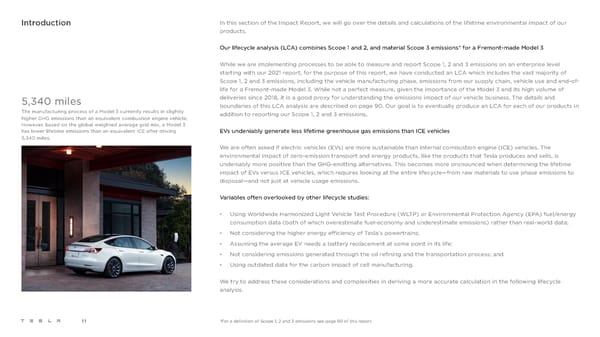Introduction In this section of the Impact Report, we will go over the details and calculations of the lifetime environmental impact of our products. Our lifecycle analysis (LCA) combines Scope 1 and 2, and material Scope 3 emissions* for a Fremont-made Model 3 While we are implementing processes to be able to measure and report Scope 1, 2 and 3 emissions on an enterprise level starting with our 2021 report, for the purpose of this report, we have conducted an LCA which includes the vast majority of Scope 1, 2 and 3 emissions, including the vehicle manufacturing phase, emissions from our supply chain, vehicle use and end-of- life for a Fremont-made Model 3. While not a perfect measure, given the importance of the Model 3 and its high volume of 5,340 miles deliveries since 2018, it is a good proxy for understanding the emissions impact of our vehicle business. The details and boundaries of this LCA analysis are described on page 90. Our goal is to eventually produce an LCA for each of our products in The manufacturing process of a Model 3 currently results in slightly addition to reporting our Scope 1, 2 and 3 emissions. higher GHG emissions than an equivalent combustion engine vehicle. However, based on the global weighted average grid mix, a Model 3 has lower lifetime emissions than an equivalent ICE after driving EVs undeniably generate less lifetime greenhouse gas emissions than ICE vehicles 5,340 miles. We are often asked if electric vehicles (EVs) are more sustainable than internal combustion engine (ICE) vehicles. The environmental impact of zero-emission transport and energy products, like the products that Tesla produces and sells, is undeniably more positive than the GHG-emitting alternatives. This becomes more pronounced when determining the lifetime impact of EVs versus ICE vehicles, which requires looking at the entire lifecycle—from raw materials to use phase emissions to disposal—and not just at vehicle usage emissions. Variables often overlooked by other lifecycle studies: • Using Worldwide Harmonized Light Vehicle Test Procedure (WLTP) or Environmental Protection Agency (EPA) fuel/energy consumption data (both of which overestimate fuel-economy and underestimate emissions) rather than real-world data; • Not considering the higher energy efficiency of Tesla’s powertrains; • Assuming the average EV needs a battery replacement at some point in its life; • Not considering emissions generated through the oil refining and the transportation process; and • Using outdated data for the carbon impact of cell manufacturing. We try to address these considerations and complexities in deriving a more accurate calculation in the following lifecycle analysis. *For a definition of Scope 1, 2 and 3 emissions see page 90 of this report. 11
 Tesla Impact Report 2020 Page 10 Page 12
Tesla Impact Report 2020 Page 10 Page 12